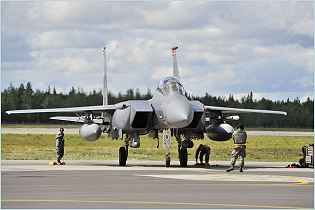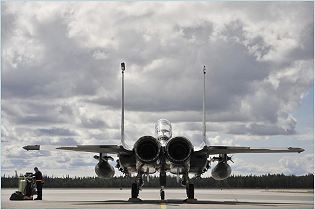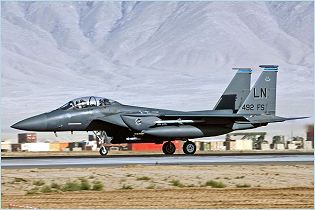F-15E Strike Eagle
| a | ||||||||||||||||||||||
|
F-15E Strike Eagle ground attack fighter aircraft
|
||||||||||||||||||||||
 |
||||||||||||||||||||||
|
The F-15E Strike Eagle is an all-weather multirole air-to-ground attack fighter aircraft designed and manufactured by the American Company McDonnell Douglas (Now Boeing). The F-15E was designed in the 1980s for long-range, high speed interdiction without relying on escort or electronic warfare aircraft. The F-15E Strike Eagle is a dual-role fighter designed to perform air-to-air and air-to-ground missions. An array of avionics and electronics systems gives the F-15E the capability to fight at low altitude, day or night, and in all weather. Previous models of the F-15 are assigned air-to-air roles; the "E" model is a dual-role fighter. It has the capability to fight its way to a target over long ranges, destroy enemy ground positions and fight its way out. The first flight of the F-15A was made in July 1972. In November 1974, the first Eagle was delivered to the 58th Tactical Fighter Training Wing at Luke Air Force Base, Ariz., where training began in both F-15A and B aircraft. In January 1976, the first F-15 destined for a combat squadron was delivered to the 1st Tactical Fighter Wing at Langley AFB, Va. The first production model of the F-15E was delivered to the 405th Tactical Training Wing, Luke AFB, Ariz., in April 1988. In addition to the United States, F-15 customers include Korea, Singapore, Japan, Saudi Arabia and Israel. The government of Singapore awarded Boeing a contract in December 2005 to produce 12 F-15SG aircraft for its next-generation replacement fighter jet, and an option for eight additional aircraft at a future date. Production of the F-15SG began in March 2007. In October 2007, Singapore exercised its option for eight F 15SG aircraft and ordered an additional four F-15SGs. F-15SG1 was rolled out in a ceremony at Boeing St. Louis on Nov. 4, 2008. Delivery of those aircraft has been completed. Boeing has delivered all 40 of the F-15K Slam Eagles ordered by the Republic of Korea (ROK) in October 2005. In April 2008, the ROK awarded Boeing a contract for an additional 21 F-15K aircraft. The final delivery of those aircraft took place in April 2012. |
||||||||||||||||||||||
| Main Variants | ||||||||||||||||||||||
|
|
||||||||||||||||||||||
|
- F-15I: Israeli version of the F-15E. It is a dual-seat ground attack aircraft powered by two Pratt & Whitney F100-PW-229 engines, and is based on the F-15E.The F-15I is similar to the F-15E, but features several different avionic systems to meet Israeli requirements.
- F-15K: South Korean version of F-15E. Several major components were outsourced to various Korean companies as part of an offset agreement, wherein Korea was responsible for 40% of production and 25% of assembly. Fuselage and wings are supplied by Korea Aerospace Industries, flight control actuator by Hanwha Corporation, electronic jammer and radar warning receiver by Samsung Thales, head-up display, airborne communication system, and radar by LIG Nex1, and engines by Samsung Techwin under license before final assembly at Boeing's St. Louis facility. - F-15S: F-15E variant for the the Royal Saudi Air Force. The F-15S is almost identical to the USAF F-15E and the only major difference in the AN/APG-70 radar performance is the synthetic aperture mode. - F-15SG: F-15E variant for Singapore. |
||||||||||||||||||||||
| Technical Data | ||||||||||||||||||||||
| Design | ||||||||||||||||||||||
|
The F-15E advanced structures utilized Superplastic forming and diffusion bonding (SPF/DB) technologies. The F-15E, while designed for ground attack, retains the air-to-air lethality of the F-15, and can defend itself against enemy aircraft. The F-15E Strike Eagle uses two crew members, a pilot and a weapon systems officer. Each of the low-drag conformal fuel tanks that hug the F-15E's fuselage can carry 750 gallons of fuel. The tanks hold weapons on short pylons rather than conventional weapon racks, reducing drag and further extending the range of the Strike Eagle.
|
||||||||||||||||||||||
| Avionics and equipment | ||||||||||||||||||||||
|
The F-15 Strike Eagle navigation system uses a laser gyro and a Global Positioning System to continuously monitor the aircraft's position and provide information to the central computer and other systems, including a digital moving map in both cockpits. The APG-70 radar system allows aircrews to detect ground targets from long ranges. One feature of this system is that after a sweep of a target area, the crew freezes the air-to-ground map then goes back into air-to-air mode to clear for air threats. During the air-to-surface weapon delivery, the pilot is capable of detecting, targeting and engaging air-to-air targets while the WSO designates the ground target. The low-altitude navigation and targeting infrared for night, or LANTIRN, system allows the aircraft to fly at low altitudes, at night and in any weather conditions, to attack ground targets with a variety of precision-guided and unguided weapons. The LANTIRN system gives the F-15E unequaled accuracy in weapons delivery day or night and in poor weather, and consists of two pods attached to the exterior of the aircraft. The navigation pod contains terrain-following radar which allows the pilot to safely fly at a very low altitude following cues displayed on a heads up display. This system also can be coupled to the aircraft's autopilot to provide "hands off" terrain-following capability. The targeting pod contains a laser designator and a tracking system that mark an enemy for destruction at long ranges. Once tracking has been started, targeting information is automatically handed off to GPS or laser-guided bombs. One of the most important additions to the F-15E is the rear cockpit, and the weapons systems officer. On four screens, this officer can display information from the radar, electronic warfare or infrared sensors, monitor aircraft or weapons status and possible threats, select targets, and use an electronic "moving map" to navigate. Two hand controls are used to select new displays and to refine targeting information. Displays can be moved from one screen to another, chosen from a "menu" of display options. In addition to three similar screens in the front seat, the pilot has a transparent glass heads up display at eye level that displays vital flight and tactical information. The pilot doesn't need to look down into the cockpit, for example, to check weapon status. At night, the screen is even more important because it displays a video picture nearly identical to a daylight view of the world generated by the forward-looking infrared sensor.
|
||||||||||||||||||||||
| Propulsion | ||||||||||||||||||||||
|
The F-15E is powered by two Pratt & Whitney F100-PW-220 or 229 engines that incorporate advanced digital technology for improved performance. For example, with a digital electronic engine control system, F-15E pilots can accelerate from idle power to maximum afterburner in less than four seconds, a 40 percent improvement over the previous engine control system. Faster engine acceleration means quicker takeoffs and crisper response while maneuvering. The F100-PW-220 engines can produce 50,000 pounds of thrust (25,000 each) and the F100-PW-229 engines 58,000 pounds of thrust (29,000 each).
|
||||||||||||||||||||||
| Armament | ||||||||||||||||||||||
|
For air-to-ground missions, the F-15E can carry most weapons in the Air Force inventory. It also can be armed with AIM-9M Sidewinders or AIM-120 advanced medium range air-to-air missiles, or AMRAAM for the air-to-air role. The "E" model also has an internally mounted 20mm gun that can carry up to 500 rounds. The F-15E Strile Eagle is equipped with 2 wing pylons, fuselage pylons, bomb racks on CFTs with a capacity of 23,000 lb (10,400 kg) of external fuel and ordnance.
Gun: - 1× 20 mm (0.787 in) M61 Vulcan 6-barreled Gatling cannon, 510 rounds of either M-56 or PGU-28 ammunition Air-to-Air Missiles: - 4× AIM-7 Sparrow - 4× AIM-9 Sidewinder - 8× AIM-120 AMRAAM Air-to-Surface Missiles: - 6× AGM-65 Maverick - 2× AGM-84 Harpoon - 2× AGM-84H/K SLAM-ER - AGM-130 - AGM-154 JSOW - AGM-158 JASSM Bombs: B61 or B83 nuclear bomb, Mark 82 bomb, Mark 84 bomb, CBU-87 or CBU-103 (CEM), CBU-89 or CBU-104 (GATOR), CBU-97 or CBU-105 (SFW), CBU-107 Passive Attack Weapon, GBU-10 Paveway II, GBU-12 Paveway II, GBU-24 Paveway III, GBU-27 Paveway III, GBU-28 (Bunker buster), GBU-31 or GBU-38 (JDAM), GBU-39 Small Diameter Bomb (SDB), GBU-54 Laser JDAM (LJADM). |
||||||||||||||||||||||
| Specifications | ||||||||||||||||||||||
|
||||||||||||||||||||||
 |
||||||||||||||||||||||
|
||||||||||||||||||||||































